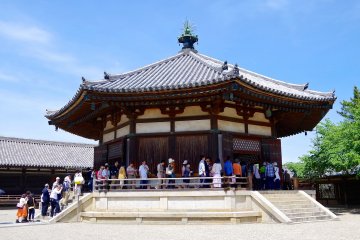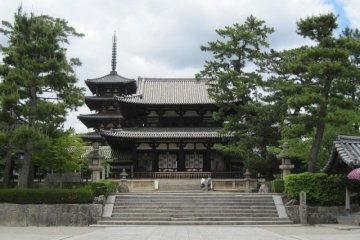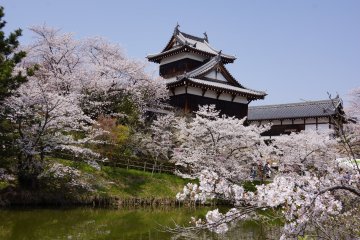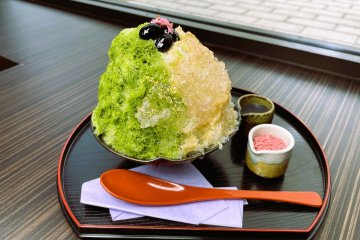The West Nara area is a cultural pocket of rich historical and cultural significance, located in the northwestern part of Nara Prefecture, just 30 minutes from Osaka.
It’s a gathering of 6 cities and towns including Yamatokoriyama City, Heguri Town, Sango Town, Ikaruga Town, Ando Town, and Oji Town. The area is steeped in traditions that date back centuries to an ancient time when Nara was the capital of Japan (710–794).

Read on to explore some of the recommended sights in West Nara before learning how the region is devising new ways to connect visitors to the traditional culture found here.
Horyu-ji Temple

Horyuji Temple, in Ikaruga Town, is one of the most famous temples in Japan. Founded in 607 it is one of the country’s oldest temples and contains the world’s oldest surviving wooden structure. It was designated UNESCO World Heritage status back in 1993 making it one of the first such locations in Japan (the other, incidentally, being Himeji Castle).
Other West Nara attractions
Shigisan Chogosonshi-ji Temple

The mountaintop Chogosonshi-ji Temple, in Heguri Town, is an ancient Buddhist sanctuary dating back to the 6th century perched on the southern slopes of Mount Shigi. It’s nicknamed the “tiger temple” given the strong associations here with this animal — an auspicious image that dates back to Prince Shotoku’s historical visits here seeking victory in his war with Mononobe Clan (it is said he prayed in the year of the tiger, on the day of the tiger and on the hour of the tiger).
Today you can witness the Fukutora statue at the entrance (considered the world’s largest papier-mâché tiger) and walk through the dark Santora No Fuku Tainai Meguri (aka “tiger tunnel”) that is believed to confer good fortune on those who pass through. Here you can also find the Shigisan-engi Emaki scroll (on display each autumn) — its manga-like depictions show historical techniques that would eventually become part of the modern manga movement.
Historic Koriyama Castle Ruins

Visit the ruins at Koriyama Castle, located in Yamatokoriyama City, to find remnants of a 16th-century castle. Constructed by Lord Toyotomi Hidenaga, Koriyama Castle played a strategic role in the region's history but was destroyed following the dissolution of the Edo Shogunate. The ruins, including the inner moat and stone walls, offer a glimpse into Japan's feudal past, with scenic views to be enjoyed around the site. During the cherry blossom season between late March and early April, you can also enjoy a nighttime illumination of the castle.
As the former capital of Japan, Nara’s position as a cultural epicenter can be witnessed in the many notable shrines and temples that dot the region.
Besides these examples, there are many more: Hokki-ji Temple (UNESCO World Heritage), Horin-ji Temple, Akunami Shrine, Darumaji Temple and Matsuo-dera Temple also contribute to the rich cultural tapestry that defines this region.
What’s new in West Nara
West Nara is devising new ways to connect visitors to the traditional culture found here.
New Goshuin Book

To help broaden understanding and appreciation of the region’s traditional culture and history, a new Goshuin-cho (a book for Goshuin, or red seal stamps) is being produced exclusively for the West Nara region.
A Goshuin book, traditionally a tangible way to record shrine/temple visits and show one’s devotion, is recommended for visitors looking for a distinctive memento that carries a unique aesthetic. What’s more, this new Goshuin book for West Nara will include inserts with helpful, multilingual info such as correct etiquette when visiting shrines/temples. It will also feature handy QR codes leading to official websites for participating shrines and temples, as well as digital maps showing how to find them.
Premium Shaved Ice

One of these digital maps will even showcase local stores serving one of Japan’s classic summertime treats: kakigōri (shaved ice).
As well as being a cultural heritage, West Nara is also considered the birthplace of ice-eating culture. Two Himuro Shrines (in Nara City and Tenri City) here are said to worship the guardian of Himuro (lit “ice room”) who is considered the protector of man-made ice and all-things refrigeration. This has led to specialities like kakigori being connected to the region, with a growing number of local stores now offering this sweet treat.
West Nara’s kakigori is also getting an upgrade thanks to a collaboration with JAL, one of Japan’s most experienced airlines. Visitors will soon be able to get a taste of the West Nara region, by enjoying an exclusive line-up of premium shaved ice options from regional stores. Using local agricultural products and regional specialities, JAL’s international first class in-flight pastry chef has been producing a new menu that is truly inspired by the local region. Given the region’s agricultural prowess and West Nara’s quality of locally grown fruits (like figs, Kotoka strawberries, pears, grapes and persimmon), the new premium menu will offer local flavors perfect for the warmer summer months. The initiative also smartly taps into the growing interest in ‘slow food’ making for more sustainable tourism but also more meaningful experiences for visitors to enjoy when visiting the region.
This exciting premium sweet treat can be enjoyed at a variety of stores in the western Nara region, available from around 2,000 yen. The store locations can be discovered via a digital map posted at shrines and temples in the area, as well as imprinted in the new aforementioned Goshuin book.












